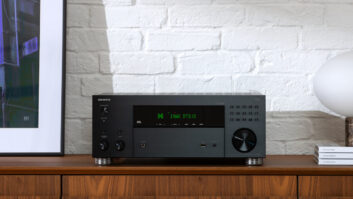Perhaps other than Sports Illustrated or Hooters, no industry is as proud of their racks as ours. (OK, that will be the only rack double-entendre, I promise! Also, as a word of caution, “rate my rack” is NOT a site where you go to submit your best AV rack pics…just sayin’…) The delivery and trimming of the AV rack often indicates nearing the job’s completion, and a clean, tight rack is a mark of pride for many installers.
Racking in gear is one of our industry’s art forms, and while I’m by no means a maestro, I recently spent two full days trimming out the house rack for my Mega Job (#protip: Bring something to kneel, sit, stand on! I used an old Tempur-Pedic pillow and my knees and butt were ever so thankful) and thought I’d share some of the things that helped us manage a 7-foot tall rack crammed to the hilt with gear.
Think Pre-Made

It used to be that you had to build your rack to order from scratch, and then assemble the behemoth once it arrived in its many boxes and pieces. While this certainly lets you get the “perfect,” bespoke design for your system, it is usually more expensive and time consuming. As an alternative, consider that most rack manufacturers—Middle Atlantic, OmniMount, Sanus, SnapAV, VMP and others—offer pre-made racks in various sizes that will save you both time and money. The racks come wonderfully pre-built, include a locking front and rear door, removable side panels, a fan system for ventilation, multiple shelves, and blanks and casters.

For my large project, I used five of OmniMount’s RE18 (18-rack space) for the bedroom suites and one RE42 (42-rack space) for the main rack. Because the pre-made racks from all manufacturers use standard spacing, you can still use any of the accessories you would like—custom faceplates, temperature controls, lighting, shelving, etc.—to finish out the rack exactly as you would like. Be advised, however, that the RE42 is one heavy mutha, and it required four of us to lug it around.
RackTools

There is a reason why so many custom home and commercial installers use Middle Atlantic products. They are not only wonderfully well made, but the company offers practically any accessory and part you can imagine to make the rack as perfect as possible. Another thing that Middle Atlantic offers that you should be using on every rack job is RackTools, which is a free software tool that offers a simple-to-use, drag-and-drop interface for designing and laying out a rack. Simply select a rack and then drag in equipment, and it will lock into place. You can even edit/create your own components if they aren’t already in Middle Atlantic’s large library. This is great tool for seeing how gear will fit into the rack and how much space you will need. Further, when you finish with the design, you can print a parts list to easily order your design with everything you’re installing. Also, I just handed the above CAD layout to my installers, and they knew exactly how I wanted the gear to be racked in, saving them additional time on the job trying to figure out how things should go.
One Wire at a Time

When you arrive at the job—especially on a large project— you are likely going to have a massive bundle of wiring to contend with. This can be daunting at first, but if you start by sorting the wiring one at a time, you’ll get more manageable bundles of like wire that’s meant to be routed to the same location in your rack. We started our racking process by cutting free all of the zip ties that we’d installed during prewire, unrolling all the wire to full length, thoroughly cleaning the wires, and then trimming and labeling them before zip tying them together again. When we were finished, we had all the speaker wiring in a bundle, the network cabling in another, the control cabling in another, the HDBaseT Cat wiring in another, etc. We then bundled all of the Cat bundles into the single, more manageable group you see above.
Power Management

One of the things that seems to complicate the racking process is power cable management. Traditionally there are one or two centrally located surge protectors with banks of 10-12 power plugs that you route all of the cabling to. But some cords are too long, some are too short, and you end up with these big clumps of power cables all in one location. One of the best things I did on this rack was to go with SurgeX’s Space Saver CM-1115-RT24. This is a lengthy strip offering 18 (48-inches) or 24 (62-inches) outlets that screws to the back of the rack. With this, every component is located immediately next to an outlet. It made power management way easier and much cleaner.

You can see a finished pic of the back of the rack and all the routed power cabling above. I’m a huge fan of SurgeX’s patented surge protection technology that ensures that every outlet in the rack is totally protected against even the most catastrophic electrical issues. A SurgeX panel has been protecting my gear at home for a few years now, and in lightning-prone South Carolina it definitely adds piece of mind that the Romex cable will literally fuse together into one singularity from a surge before my gear sees any bad juice.
Labeling

No one should need to be told about the importance of labeling wiring, but if you’ve ever gone behind another company’s rack then you know that this is still something some installers don’t do. On a big rack with potentially hundreds of cables in place, having a label on the wire is great, but it can still be difficult to wade through all that wiring to find the one label you’re looking for. For example, at the top of this rack are two Pakedge switches with 48 ports. That’s a lot of wire no matter how neatly it is bundled, and finding the single cable you need can be frustrating.

On this job I created the above connection diagrams of the gear. This was easily done using MS Paint and took about 30 minutes. A laminated copy of this will stay in the client’s file and in the rack, making future service calls and diagnostics trips easier when locating the source of a problem.
While we were trimming the rack, nearly every trade in the house, along with the builder and the homeowner, stopped into our utility room to take a peek to see our progress and check out our work. And while the rack is only a small part of the project—and admittedly not as important as the system’s user interface as Heather Sidorowicz eloquently espoused here—and even if it is something the customer will rarely or never see, a properly built and wired rack will make your life easier going forward whenever you need to return to service the system.

John Sciacca is principal of Custom Theater and Audio in Myrtle Beach, SC.







